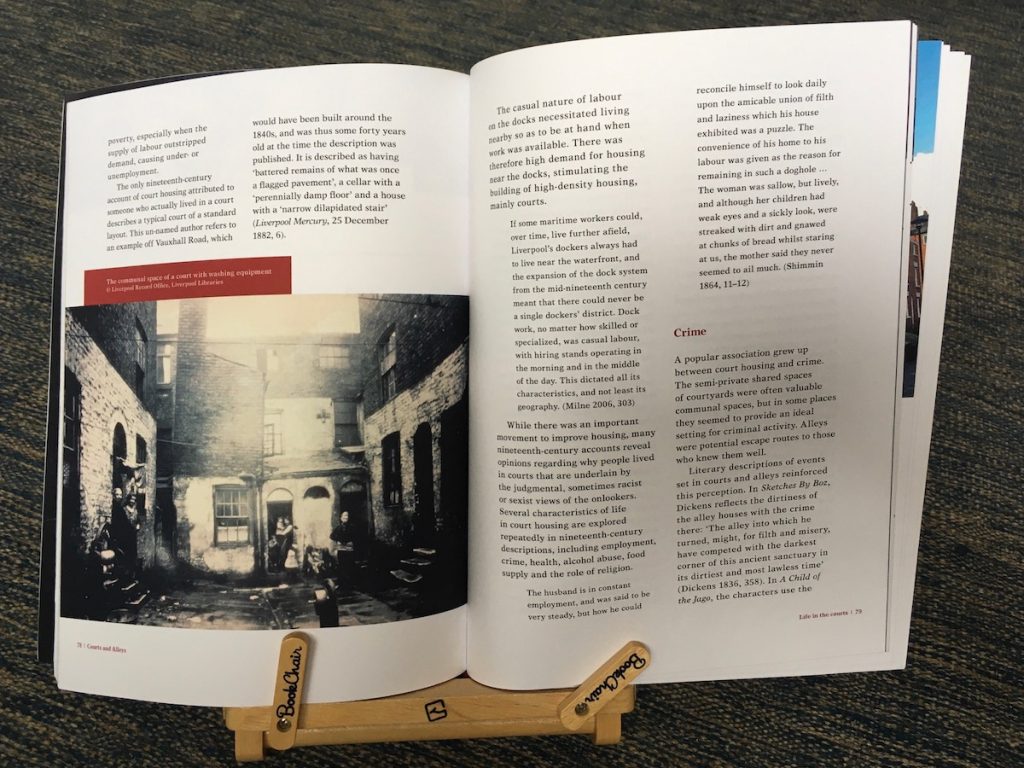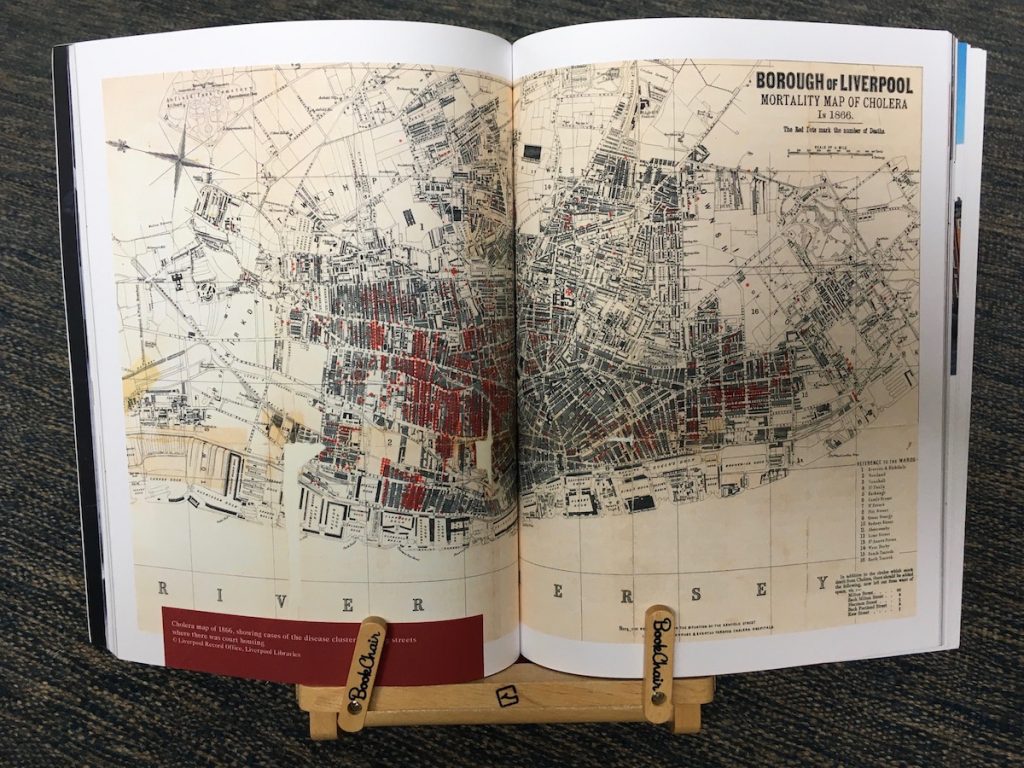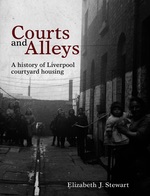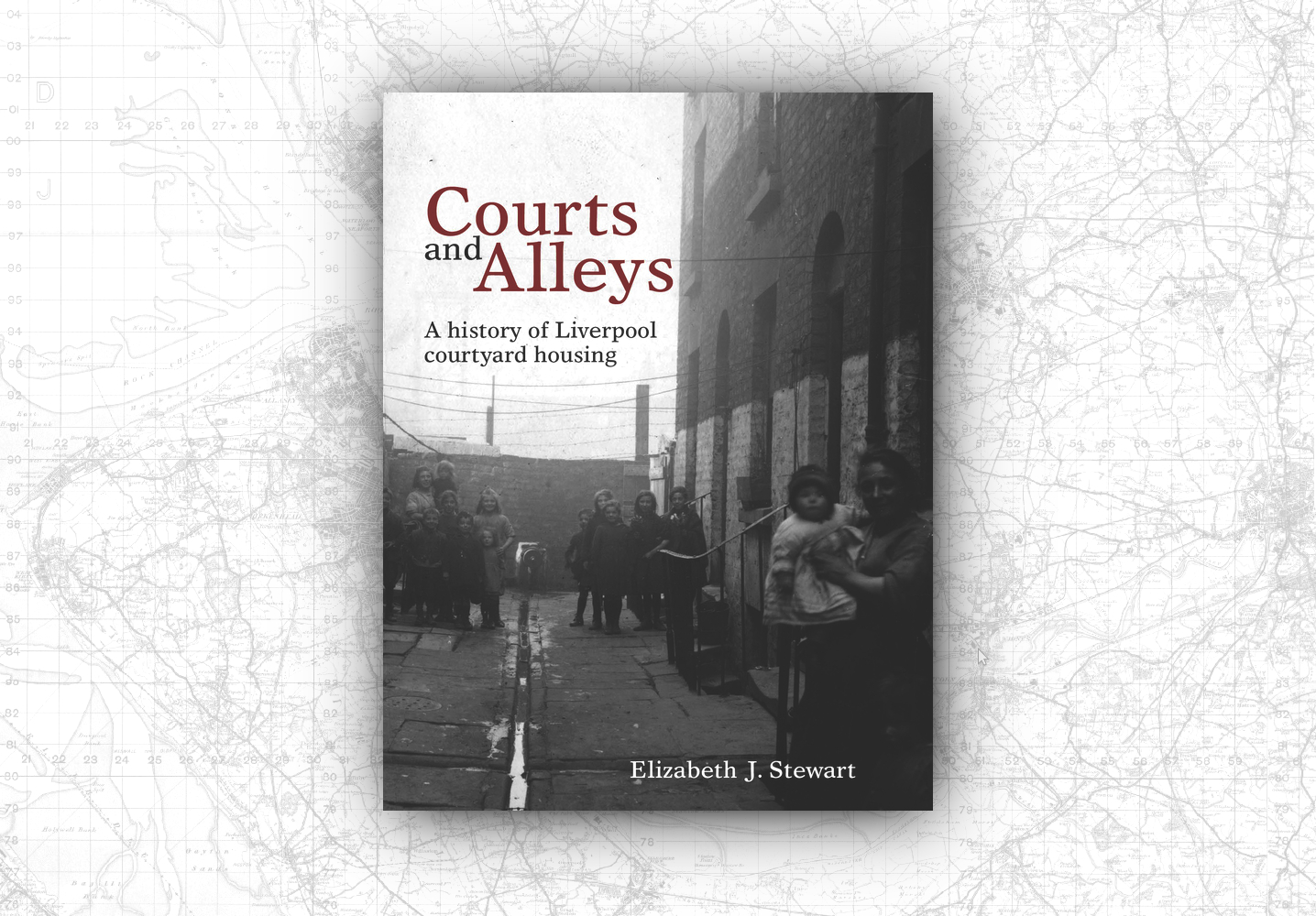This book is part of the output of the ‘Galkoff’s and the secret life of Pembroke Place’ project. (See my article on a talk by Liz Stewart, this book’s author). It doesn’t cover the court houses archaeological excavations which took place as part of the project, which will come in a later publication.
Court houses and the Victorian city
Court houses were a feature of the very dense residential areas of Victorian cities. They consisted of a set of houses facing onto a courtyard (hence the name), which was accessed at one end through a narrow alley or archway.
They remain notorious for the number of people who were housed in them – sometimes multiple families to a room – and the poor quality of their construction. For many people today, court houses typify the class divisions of Victorian society, but they were also a hot topic for contemporary commentators. Hugh Shimmin, of the satirical Porcupine magazine, was perhaps the most prominent but, as this book shows, plenty of people had much to say on the problems for the people living in them.
History of court houses
Courts and Alleys charts the whole history, from the earliest appearance to the remnants on Pembroke Place. It’s fully referenced, but the tone is very readable and not too academic.
The number of references makes this a useful reference book for research, and I’ve bought at least one book on the back of reading about it here. The long bibliography is a great jumping off point if you want to, for example, research your family history locations more closely.

It’s great strength is the level of illustration. It’s a colourful book in any case, but there are dozens of photographs and maps that let you get to the heart of the issue. There are some classics which you might have seen before, but plenty you won’t have, both inside and outside shots, some of which are truly shocking, especially when you take into account their recency. Many are from the Liverpool Record Office, accompanied by quotes from their oral history collection.
There are also potted biographies of the people who played important roles in the history of court housing, such as George Buchanan who went some way to dispelling the myths about Irish laziness and immoral living as root causes of the problems in courts.

Improving living conditions
One of the many fascinating extra snippets of information that the book provides is that some of the courts were built by converting old large houses. Their entrance halls became the archway through which many courts (not just the converted ones) were entered.
The history of courts melds into the introduction to better public services like sewerage, gas lighting and running water. Courts, of course, often provided only one or two standpipes to two dozen people, and were dimly lit.
The night soil men (those who collected and cleared the latrines) were only contracted to wash courts and passages if their was a water hydrant within 30 yards.
But the earliest attempt to keep the town clean came as early as 1748, attesting to the tardiness of attempts to provide decent accommodation to court residents. The list of 19th century Acts which tried to improve housing is 65 years long!
Opposition came from landlords, who benefitted from cheap building costs, the House of Lords had no remit to raise taxes to pay for improvements, and fretting over the perception of government interference resulted in watered-down measures.
Even the sainted Dr. Duncan comes across as critical of the people in courts, edging on xenophobia (against the Irish again) or snobbishness towards the working class.
Here, there and (nearly) everywhere
The book goes on to put Liverpool in the national context. Courts were mainly a feature of the north of England and the Midlands. Cellar dwelling, often seen as the lowest of the low, was a Liverpool ‘speciality’, though not much less common in London and Birmingham.
But the book ranges further, comparing not only the courts of different cities in Britain, but looking across the pond to Manhattan and other US examples.

Liverpool’s landscape seems to be part of the issue: the river created a western barrier to development, while at he same time the docks attracted thousands of workers who needed to be housed within walking distance.
Victorian Commentary
I’ve mentioned the Victorian discussions which surrounded the scourge of court houses, and the fates of the people who lived in them. Stewart discusses this too, concluding that the residents were constrained to live in these awful conditions because they simply had no other options.
They couldn’t afford anything better, and there were few other house types – as Marx noted for Manchester – close enough to the mills were they worked.
Not all court houses were created equal. Build quality, standards of maintenance and the living conditions experienced by people living in them all varied. But even at the time the press tarred them all with the same brush: uniformly bad, and generally the fault of the residents.
There was a heavy anti-Irish slant to commentary back then too. Our modern ideas of court houses suffer the same generalising principles; more nuance is needed, and this book attempts to introduce that to us.
After the courts
Of course, things did eventually improve. The first council houses, St. Martin’s Cottages, were built in 1869. Other ‘enlightened’ settlements were built at Port Sunlight and Bournville.
The two Liverpool examples embodied the controversy over whether housing was a public or private concern, a local or a central one. The housing by-laws can be seen as a compromise, where government set the standards that private developers had to adhere to. Hence when we refer to ‘by-law houses’ we mean those which were built in accordance with these pieces of legislation.

What impresses about this book is that it covers the period right through to the post-war clearances of ‘slum’ houses, linking the issues of the courts with more recent worries about approaches to housing thousands of people in suitable places.
Perhaps surprisingly, it’s not just the Pembroke Place courts which survive from this class of small dwelling. There are still back-to-backs in Liverpool, as illustrated by a modern photo of Duke’s Terrace, off Duke Street. These houses have, as you might expect, been converted into modern dwellings, by knocking them through so the building has two ‘fronts’. If nothing else, this proves that not all these small houses were poorly constructed.
As this book demonstrates, it was the factors surrounding living conditions – the number of people in each house, the lack of amenities, and social attitudes to the working class – that shaped these places.
Buy the book

The book is available now for £7.99. There are two good places to get it from:
- Courts and Alleys from the Museum of Liverpool shop, or
- Courts and Alleys from the Hive network, which helps support independent bookshops near you.
(Disclosure: if you buy via Hive, this website gets a small commission to help keep it running).

Iain Taylor
says:Congratulations on the book launch, Elizabeth!
I hope you can share a signed copy!
Warm regards,
Iain Taylor
Iain Taylor
says:Still awaiting a response, Liz!
Iain Taylor
Stewart Smith
says:I used one of the suggested sites to order a copy of Courts and Alleys – Liverpool University Press. I was charged £4.80 for Royal Mail 48 hour delivery and am still waiting a week later. The LUP use Turpin as their distributor and the online reviews make me wonder if the owners first name is Dick.
You can get the book on Amazon with free delivery if your order qualifies, delivery guaranteed.
Martin
says:Hi Stewart,
Sorry to hear that. I know from my own shop that Royal Mail sometimes struggle at the moment, and I suspect the problem is with them rather than Turpin, the wholesaler. Nevertheless, thanks for pointing this out. I’ll think twice about recommending LUP as a shop in future.
Martin
Stewart Smith
says:Thank you Martin. The issue is definitely with Turpin but LUP have been very dismissive of the problem
Martin
says:Oh dear, I bet they have! I had some issues with my distributor so now I order everything in to me rather than post direct. LUP definitely should take charge of the problem!